It is said about Krásná Lípa, that it is an island of positive deviation. It’s called right. This town has undergone a very positive development over the last twenty-five years and has become an attractive place for both tourists., as well as for people, who live here. You will actually find everything here, what a person needs for life, sometimes to a surprising degree, given the size of the city. The surroundings are blatantly beautiful, Krásná Lípa is the border town of three breathtaking regions – the Lusatian Mountains, Czech Netherlands and Bohemian Switzerland. When you add, that to Upper Lusatia in Saxony, it’s some eleven kilometers, The Zittau Mountains and the entire Upper Lusatian Basin will also open up to you. Krásná Lípa is a perfectly strategic excursion and relaxation place for all this. So let’s walk through the city, whose history dates back to the depths of the thirteenth century, when I’m probably Přemysl Otakar at the invitation, of the other name, settlers from the Bavarian Upper Franconia arrived and began to build a settlement around a massive ancient tree, expansive and beautiful lime trees.
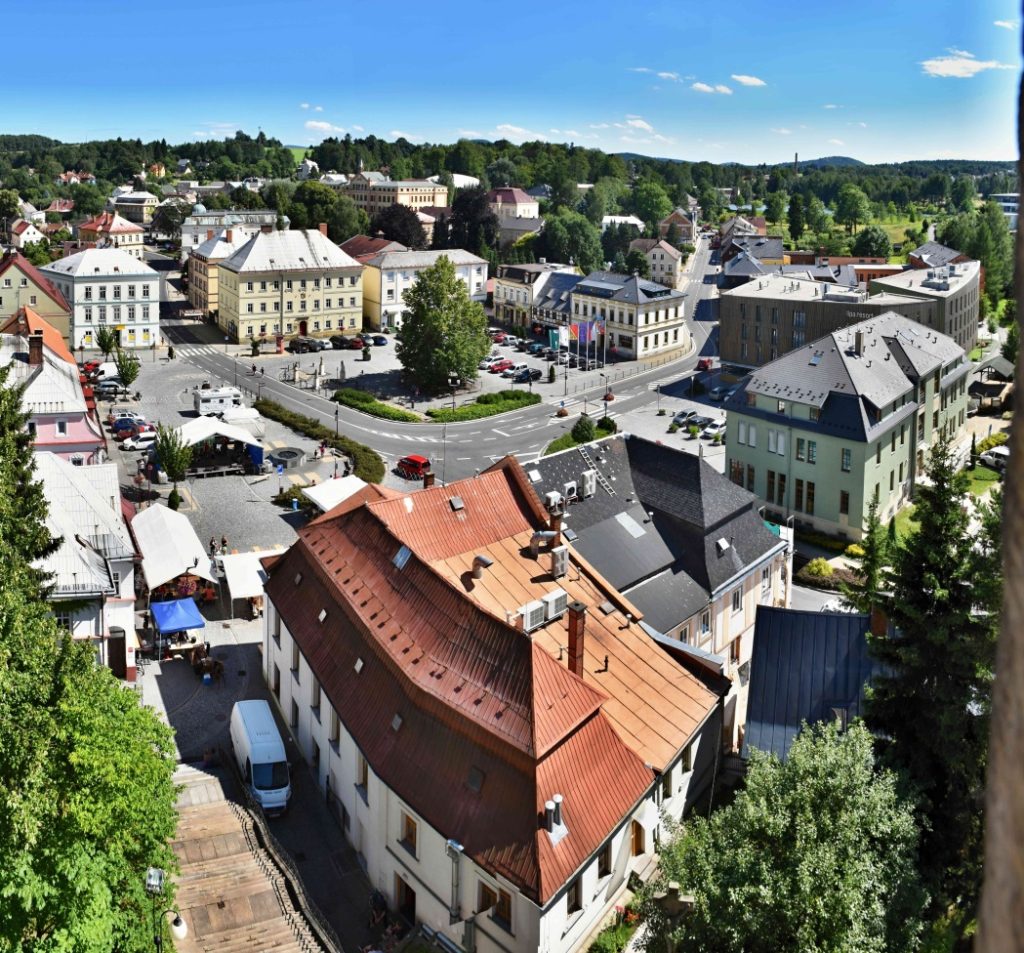
Let’s start with the tower of the church of St.. Mary Magdalene. It is only open to death, mostly about some bigger events. I was lucky at the rock beer festival Krásnolipská nádhera, which is organized by the Falkenstein brewery every August. Brewery, these are the two embracing buildings below us – the one with the red roof and the one with the gray one, which, however, some time ago turned bright white – but later. Now let’s enjoy the view from above of Křinické náměstí.

Křinické is not called in vain, the river Křinice flows through it, which springs quite close – and in Škapulír we will certainly get to its sources. The painter from Krasnolip, August Frind, painted the square at the time (the year was written 1909), when the Křinice riverbed was covered for nineteen years – and the river still murmurs below the surface – however, he materialized his memories of the bridged stream and the four statues guarding the footbridge.

The baroque church of St.. Mary Magdalene, respectively its tower visible from afar. This place has long been sacred. Since 14. century there was a church, which then in baroque, as was usual at the time, demolished and built a new one.

The interior is beautiful, especially the slightly arched emporiums catch the eye at first glance. In addition, the local organ is again a concert instrument after reconstruction, wonderful events take place here in the summer, which are worth seeing and especially hearing.

Well, just look at them – they are not beautiful? And not at all, the whole church?

Waiting for the opportunity to climb the tower is really worth it. I always feel like Foglar ‘s Jan Tleskač fleeing the mysterious M.

Especially, when I can look at the gigantic ground, which stretches over the whole nave and over the presbytery. Stunning space.

At the Magdalen bells, I feel like in the freezing detective story of Ernst Hall, a native of Chomutov. (despite the ruthless tooth of time, is celebrating its 100th birthday this year) Death bells. Idea, that they suddenly start moving, it always scares me reliably. You can hear the sound of these bells all over the city every quarter, and it’s a comforting sound, ancient and beautiful. Only here did I realize, how the bells disappear from our lives, as well as street clocks. You noticed that? Like we want to laugh at time. We pretend like little kids, that if we ignore his messengers, time will stop and we will be immortal.
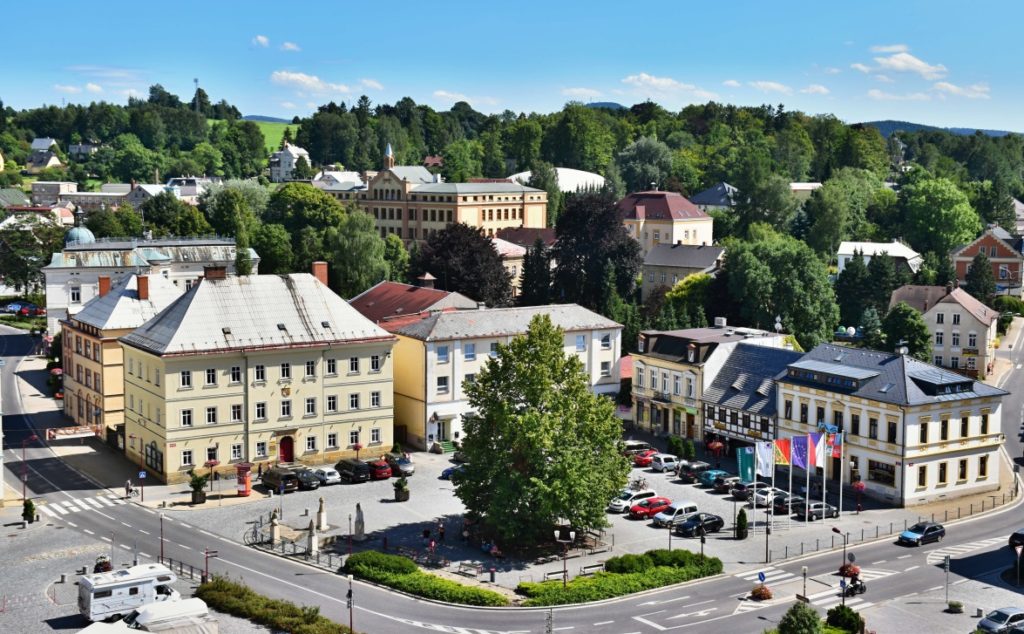
But the outlook is worth any literary reminiscence. This is the southeastern part of the square, which is today – with one exception, the pride of the city. About the exception, from here mercifully hidden behind a beautiful linden tree , there will be more talk.
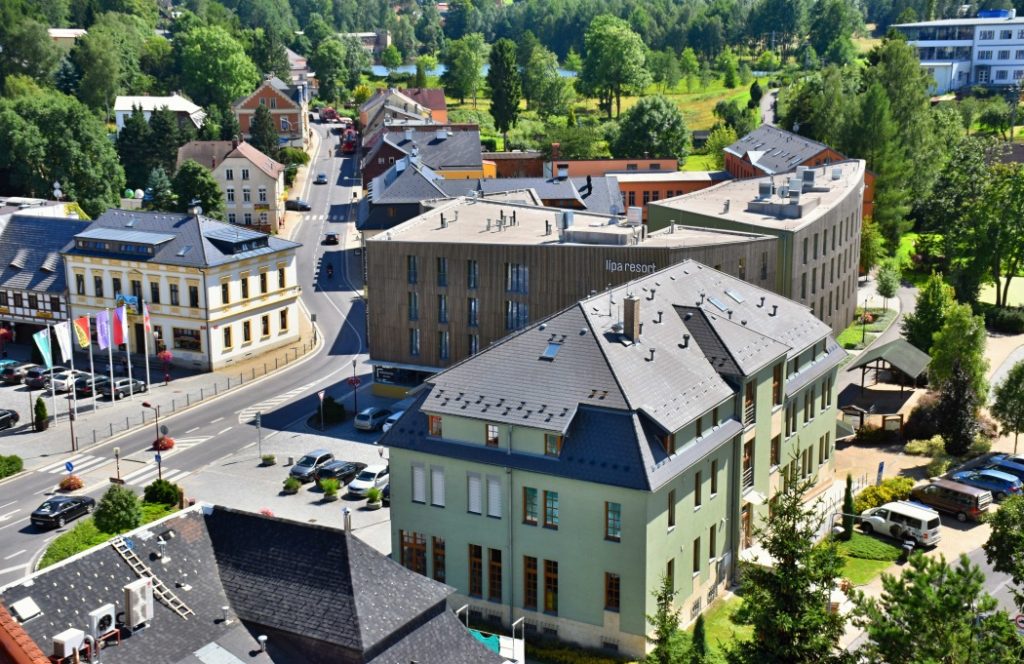
The southwestern part of the square, for example, is dominated by two new buildings, which they certainly do not disgrace. The green building is the seat of the non-profit company Bohemian Switzerland, which on the ground floor and basement hides a remarkable interactive exhibition of the cultural landscape of the land of rocks and gorges and a well-equipped Information Center. The corner building is a complex of Aparthotel Lípa, which does not deny its creators with typical features, namely the Hoffman studio. If it reminds you of the new post office in Sněžka, then rightly – it is from the same authors. Across the street is a house full of sweet secrets. The wonderful Mana chocolate factory is located here, social enterprise. Don’t have hot chocolate and taste the local pralines or even hear the temptation of the local chocolate creative workshop and not try the shaping of chocolate, that is a sin, who is not forgiven at the Last Judgment.

However, Křinice and the bridge over it did not completely disappear, only their form and function changed. The city addressed the Kadan sculptor Herbert Kizs, to depict the ancient dominants of the square in his own style. Managed. The riverbed is stone, as well as the stylization of the water itself and the footbridge, the sculptures of the saints are lined with sculptures of the four elements. And if you look at the photo carefully, you will discover the Falkenstein brewery in its already finished form, thus also with the white and white house hiding the brewery’s production premises. You will find yourself in the next “pub” very decently. And the local beer? Good. Dot. Year, it is the Falkenstein slogan, but it is also true. He lives here all year round, because Krásná Lípa has not been a sleepy nest for a long time. Throughout the season, however, the brewery restaurant expands into the square, so if not inside, you will probably sit outside.

The square is really worth a thorough walk. And pay attention to details. For example, beautiful stone linings of house doors…

… Or this unrivaled cutest house on the square. It’s a bit like dolls, and older individuals probably can’t mess with it.

Another handsome man. And fragrant again! Sem, to Chodská pekárna U Šedými, you will be reliably drawn by the smell of fresh pastries – salty and sweet delicacies, of which the medal would deserve especially the naughty good lard cakes.

Do not miss the memorial plaque on the north side of the square. She pays tribute to the amazing technical visionary here, Albin Hugo Liebisch, creators of the most beautiful motorcycles in the world.

Every year every year, always at the very end of August, The meeting of the owners of Liebisch motorcycles Čechia-Bohmerland will take place on the square. There are dozens of them here and then, what the enchanted snowshoes will see to the fullest, sets off on a fun ride around. Something unique!

Every year every year, always at the very end of August, The meeting of the owners of Liebisch motorcycles Čechia-Bohmerland will take place on the square. There are dozens of them here and then, what the enchanted snowshoes will see to the fullest, sets off on a fun ride around. Something unique!

We will end the puffing around the square with another treat, this time in Café U Frinda. This is because Křinické náměstí is seriously edible. Ice cream will not disappoint you, nor soup menu. And they can make very good coffee. But the house itself is also interesting. It’s called U Frinda, but it has nothing to do with the painter August Frind. The oldest preserved house in the city, built in 1729 – belonged to the Zillich family for more than a hundred years, important and respected doctors. It is unknown, what the Zillichs had in the yard, and many do not know either, what is there today. So let’s take a look…

And let’s see – a pleasant garden! There is usually peace despite the nearby road leading from the square. Such a cafe oasis in the middle of the city.

Speaking of cafes, let’s visit the other two, which are in the immediate vicinity of the square. The Nostalgie Café is quietly in front of a really beautiful half-timbered house.
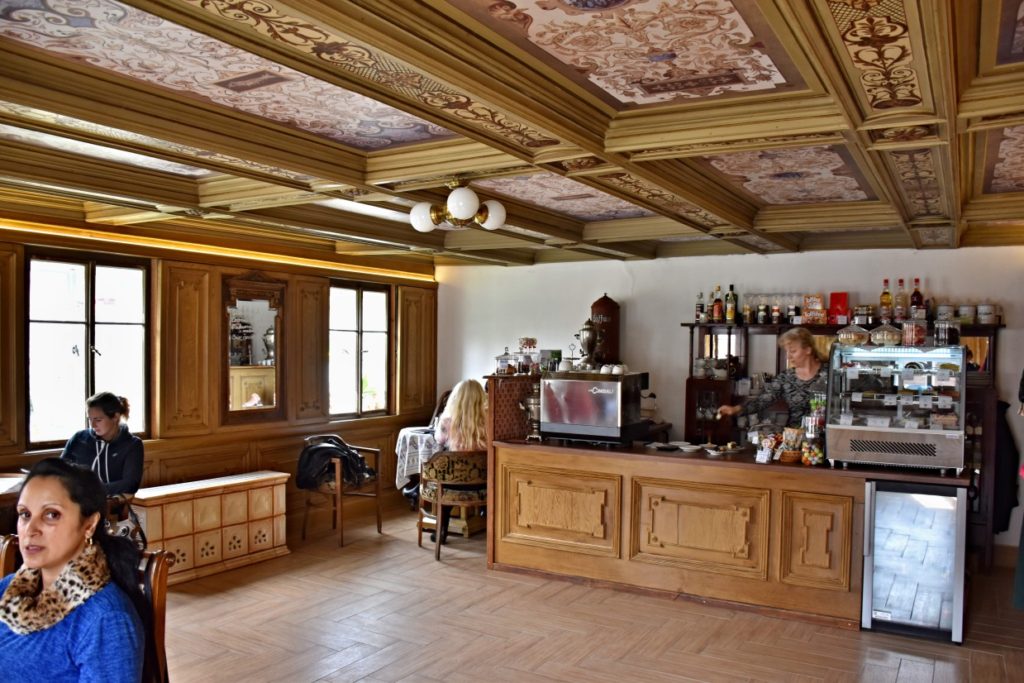
The beautifully archaic interior does not suffer from butcher’s syndrome, it’s not overpriced. And the painted ceiling excites at first good. The assortment of classic desserts is complemented by homemade profiteroles and wonderful apples in a bathrobe. Edith Piaf often takes care of the atmosphere here. Idyll and peace.
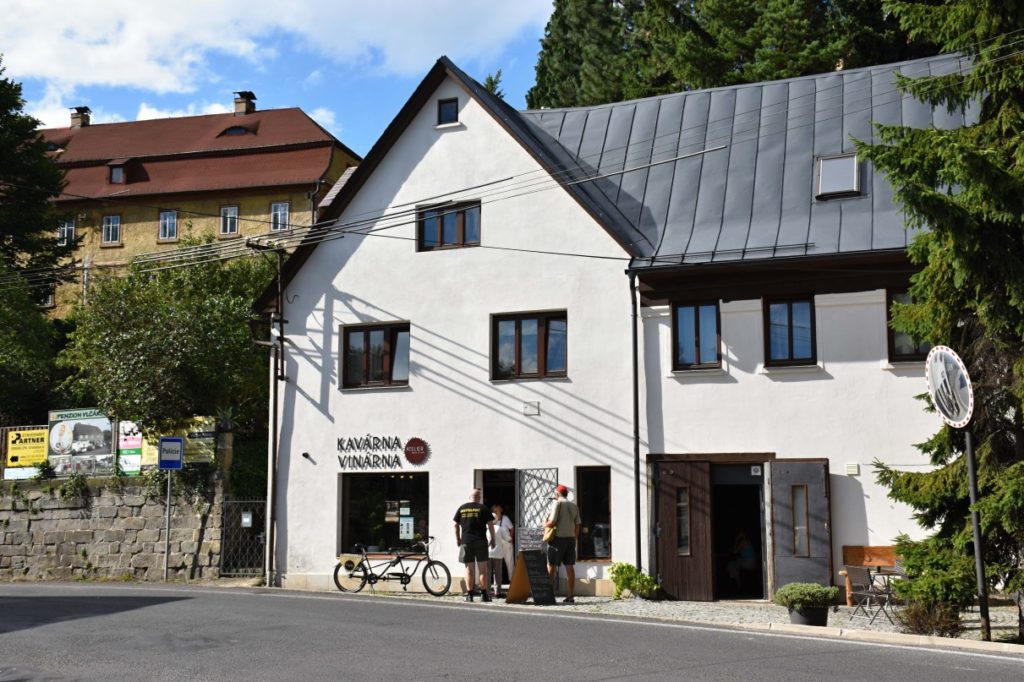
Atelier Krásná Lípa Café is completely different. It is located in the house just behind the Falkenstein brewery.

The character of the cafe is far more urban, subscribing to the trends of the spirit of Karlín and other Prague cafes. A big plus is the inspiring wine shop (they even have Georgian wines here, which you don’t meet so often). The coffee is made from freshly roasted beans from a local roastery and is really good.

The owners Jitka and Miloš Kubišt are also musical people, you will often come across paintings and graphics here in the shop window and indoors, whose authors are. Everything is calm here, neocase juice, for the pleasure of locals and guests.
Our next goal will be beautiful villas and houses in Lipno. Remarkable are blessed here. Their queen, neo-renaissance Hielle’s villa, you already know from Scapular, you could even look inside, so I will not get tired of repeating what has already been said. However: it’s a gem.
From Škapulíř you also know a dignified villa rising nearby, which Carl Dittrich had built in 1912 in memory of his mother – by the way, it was built in just three years. The original purpose was the Youth House, but during the war there was a hospital and shortly after the establishment of the republic there was an orphanage. After the Second World War, a children’s sanatorium was established here, and since the beginning of the third millennium, the Administration of the Czech Switzerland National Park has been at home here.. These are austere facts. But the house is, addition, above all beautiful.

Krasna Lipa, similar to other nearby cities in the Czech Netherlands, is full of exhibition villas, which you in the second half 19. and in the first decades 20. century was built mainly by owners of textiles and other factories. For example, this magnificent historicist Kessner’s villa is from 1866. Its current owners call it Romantic Chateau, they run a hotel here and, in a rather Barnum style, call it “one of the most beautiful castles and chateaux in the Czech Republic”. No, so it certainly isn’t, but it is undoubtedly a remarkable example of the taste of the time.

Only the monogram E.K refers to the original owner. executed decoratively in wrought iron grilles.

The beautiful Villa Römisch is only a few tens of meters away. This house, nicely dressed in a suction cup, it has a special feature – if you look at it for a while, you feel, that this is where you could live.

In the end, I kept the most famous villas after the observation of the villas from Krasnolip. Palm’s villa. It is probably the largest functionalist villa in the Czech Republic and was built by the textile entrepreneur Josef Franz Palme in 1926 according to the plans of the renowned Dresden architect Hans Richter. Today, the Home with a special regime is located here. Beautiful building – with a picturesque history.

When Josef Franz Palme and his brother-in-law Adolf Schindler finished the factory, Josef decided, that he will have a magnificent historic villa built on the slope above the factory. In 1911 was completed and Palme’s family moved in enthusiastically.

But then Palme discovered an amazing architect, Hans Richter of Dresden, a native of nearby Königswalde, today the Kingdom. His functionalist thinking completely enchanted him and he entrusted him not only with the construction of a new knitting mill, but also their new villas. He had the exhibition villa demolished to its foundations after only sixteen years, and Richter built a functionalist gem at his disposal., which was completed a little earlier, than the revolutionary building of Schindler’s Knitwear, an industrial monument comparable in value to the Prague Trade Fair Palace.

And now one story from a drawer of sad paradoxes. The sublime and ornate Deutsches Haus, former hotel, cultural hall and social center of the city built in 1884, you can still see it on Křinické náměstí. But… (For better orientation, If we go inside, where the fountain with the statue used to stand, linden is growing today.) During the time of real socialism, the building was slightly modified, to match the current. How did it end up?

Terribly. One does not even want to believe, that under that monstrous façade, the former beautiful neo-renaissance building is really suffocating. The only encouragement is, that this is the last stain on the face of a really beautiful and hospitable square.

Krásná Lípa is simply full of remarkable houses. In particular, one species dominates. Pedestals, pedestals, pedestals – the treasure of this region shines here as well. This, for example, is an example of an absolutely fundamental type of pedestal combined with a half-timbered floor(with already finished ground floor) in a very bloated design – there are not that many massive half-timbered houses.

This pedestal is again remarkable with a mansard roof, which hides the attic resting its weight on the base structure, which many mistake only for decoration. Construction gimmicks aside – for these houses (and that there are them in Krásná Lípa!) it’s a pleasure to look at! They create a characteristic color of the whole region.

From the number of crosses in the city, I chose the one standing at Kyjovská Street. It is Kögler’s cross. (I have to note, that Kögler was a very common name in this area, so please, not to be confused with another cross of the same name, which you already know from Scapular.) This one was set up by the farmer Gottfried Kögler. However, the cross looked completely different – was iron, decorated with metal silhouettes. (By the way, I eagerly recommend to read Natalie Belisová’s excellent book Journey through the Spiritual Estate of Krásnolipsko.) You can find it at Römisch’s villa.

As we roam the city, we can’t miss one of the most beautiful animal sculptures, as far as I know. It is a real pride of Krásná Lípa. A metal statue awaits us in sight of the city park with immense patience. It is actually a monument to the fallen in the Prussian-Austrian war, whose names on the bronze plaques used to be placed on a granite plinth. He was discovered in 1908 on the occasion 60. anniversary of the reign of Francis Joseph I. and as a celebration of fifty years of activity of the Association of Veterans in Krásná Lípa. You can often come across a description, So the Lobendav builds a pillar for her here “Czech lion tears a Prussian eagle to pieces”. I would be more careful, I don’t think anything is torn to pieces, it just expresses dominance, very dignified as a beast over prey. And the author of this beauty? Dresden sculptor Moritz Clemens Grundig.

Grundig was no hello, he was a highly sought-after Dresden sculptor, which, by the way, created a very similar lion monument in Grumbach, Saxony . Here you can see his ornaments and sculptures at Dresden’s Wettin Obelisk. You won’t see him today, In 1942 as part of the German people’s campaign for metal donations to the Führer, all metal elements were, hence the ornaments and statues, dismantled and turned into cannons.

I dedicated the entire fifth Scapular to the world-unique Dittrich tomb with a heating plant, so perhaps only its current state after the basic rehabilitation. The tomb is waiting now, when the town of Krásná Lípa manages to solve new administrative entanglements and will be able to take over and invent the building, how to save her.

The city park actually begins with the tomb. He is beautiful. And the tourist’s foot rarely gets lost here, not even the locals come here that much, how much this colorful oasis deserved. And so there is peace, silence, regular bird concerts, in May, flower explosions of woodpeckers and azaleas, stream, pond… Here – but actually everywhere else in the city – is greatly appreciated, that the longtime mayor of the city is the original profession (and souls forever) gardener.

And if we’re at the park, we are only a few steps to a large city pond called Cimrák. It’s relieving
ride on it in a boat, Alternatively take the small sandy beach.

Before the war, the city council sat and negotiated in the building on the square, later, the deputies moved to the former city savings bank. She lost her sculptural decoration, but it is still a beautiful historic house.
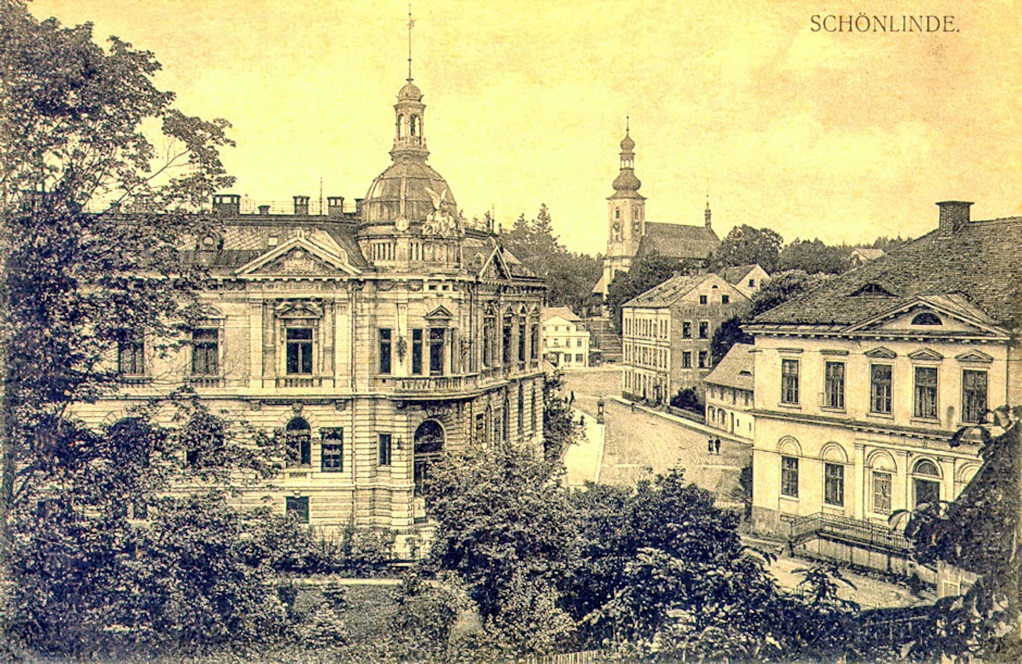
Neo-Renaissance building with Art Nouveau elements completed in 1900 – Here with a complete angelic suite on the front of the turret.
And one more building is worth stepping out of the square. Today it is a retirement home, but it used to be Empress Elizabeth’s Hospital. Her appearance has not changed that much, at first glance, only a slightly soulless square replacement of the original decorative entrance is visible…

which is clearly visible in the beautiful historical picture. For the hospital (as well as for many other benefits) Krásná Lípa owes the Dittrich family. Carl Dittrich and his sisters and mother Teresa donated the land for the construction and contributed a substantial amount of fifty thousand gold. Carl then took care of the interior equipment. The Boromejka sisters took care of the operation of the hospital with forty beds.

Let’s take a look at some buildings and places, which do not allow an observant pedestrian to sleep. What could be so wasted was this? If you are guessing a historic fire hose dryer, reward yourself, you won. It is even protected as a monument! However, he is also the proud fire brigade of Krásnolip in the year 1864.

Not even a really generous space above the road to Krásný Buk will come out of your head. Solid stone walls suggest, that something big and fundamental was happening here. And it also does – Villa Hirsch, that is, the Deer.

It has been built several times by Dittrich, family of textile businessmen and patrons of the city. It was a multi-purpose house, in which lived a fairly large family, but there were also Hielle offices&Dittrich. (By the way, son of the company’s founder, Carl Dittrich, he had a villa near Dresden called Weißer Hirsch (White deer), so it seems, that the Dittrichs were really dropped out of college.) It is a sovereign pity, that the villa is no longer standing, could be another gem of the city.

I know, it’s not fair, showing you something, what is gone… But I know from personal experience, how such an abandoned chimney haunts a person in the head. Where did he come from?? What he served…

Especially, when in the immediate vicinity is a remarkable villa, which you can read about, that it is Jäger’s villa. Water flowing from a well in the area opposite the villa (here again used to be a cruise restaurant Green Thursday) it is delicious and people come here for it from afar. Just on the sidelines, the beautiful stone tank also has its own, comes from 1823… So there was a factory, or not?

Of course, that she was. This is the chimney and the villa, which quietly decays neglected by the owner, who is said to live somewhere in the USA, they make sense, So the Lobendav builds a pillar for her here? Since year 1893 the famous knitting mill of Gustav Jäger used to stand here, in which seamless women’s stockings were made, men’s socks, Children’s tights, jackets, nightgowns and yes – and familiar underpants, so. jägrovky. She used to have her own steam engine. After the war, the family was expelled and the factory buildings fell into disrepair. They were torn down around the year 2000. All that was left was a chimney. You were interested? I just think, that it is good to be part of the collective awareness of things – across time. Because even that is beautiful, Design matters, what preceded us.

The last house, to which I will point out, de facto no longer in Krásná Lípa (as well as Jäger’s villa). But the formerly important Buk Buk has long been a part of it. But the villa is so beautiful and picturesque, that don’t invite you, to check it out, it would be a mistake, which you could rightly blame me. That’s how the owner of a saw once, pan Alfred Hieke, that he will have an office building built, to have his subordinates where to serve. When it was done, the sawmill’s wife intervened, which vigorously declared the house a family home, and so the offices became flats. The post-war development was not very favorable for this jewel of folk architecture, seek women behind everything. From Beautiful Beech, specifically from Jäger’s villa, you have it following the blue tourist sign to Bohemian Cottage 1300 m. You enjoyed the walk?

So we are closing the eighth Scapular, who wanted to prevent the saying “There is darkness under the candlestick”. Krásná Lípa is in sight from Bohemian Cottage. It would be sad, not knowing such an interesting city, when a person has a quarter of an hour’s walk from the lair. Rosťa Křivánek greets you all.
Published on: 10.1.2024 - Filed under: Blog - Tagged: Krásná Lípa and surroundings, The Scapular

